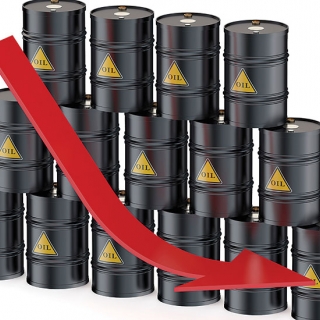


Oil prices fell on Monday (August 4th) after OPEC+ agreed to a major production increase in September, which will boost supply. However, concerns about disruptions to Russian oil shipments to top importer India limited losses.
Brent crude futures fell 18 cents, or 0.26%, to $69.49 a barrel at 04:56 GMT, while U.S. West Texas Intermediate crude was at $67.21 a barrel, down 12 cents, or 0.18%, after both contracts closed about $2 a barrel lower on Friday.
The Organization of the Petroleum Exporting Countries (OPEC) and its allies, known as OPEC+, agreed on Sunday to increase oil production by 547,000 barrels per day for September, the latest in a series of accelerated production increases to regain market share. OPEC cited a healthy economy and low inventories as reasons behind its decision.
This move, in line with market expectations, marks a full reversal and the beginning of the largest OPEC+ production cuts, plus a separate production increase for the United Arab Emirates, which amounts to about 2.5 million barrels per day, or about 2.4% of global demand.
Analysts at Goldman Sachs estimate that the actual increase in supply from the eight OPEC+ countries that have been increasing production since March will reach 1.7 million barrels per day, as other members of the group have cut production after previously experiencing overproduction.
"While OPEC+ policy remains flexible and the geopolitical outlook remains uncertain, we assume that OPEC+ will maintain its required production beyond September," they said in a note, adding that non-OPEC production growth will likely leave little room for additional OPEC+ barrels.
RBC Capital Markets analyst Helima Croft said: "The bet that the market can absorb additional barrels appears to have paid off for holders of spare capacity this summer, with prices not significantly different from pre-Tariff Free Day levels."
However, investors remain wary of further US sanctions on Iran and Russia that could disrupt supply. US President Donald Trump has threatened to impose 100% secondary tariffs on buyers of Russian crude oil as he seeks to pressure Moscow to halt its war in Ukraine.
At least two ships loaded with Russian oil bound for refineries in India have been diverted to other destinations following new US sanctions, trade sources said on Friday, and LSEG trade flows showed. This puts about 1.7 million barrels of crude oil per day at risk if Indian refineries stop buying Russian oil, ING analysts led by Warren Patterson said in a note.
This could potentially wipe out the expected surplus through the fourth quarter and 2026 and give OPEC+ the opportunity to begin winding down the next tranche of supply cuts totaling 1.66 million barrels per day, they added.
However, two Indian government sources told Reuters on Saturday that the country would continue buying oil from Russia despite Trump's threats. Concerns about US tariffs impacting global economic growth and fuel consumption are also haunting the market, especially after US economic data on job growth on Friday came in below expectations.
U.S. Trade Representative Jamieson Greer said on Sunday that tariffs imposed last week on several countries would likely remain in place rather than be reduced as part of ongoing negotiations. (alg)
Source: Reuters
Oil prices were steady on Tuesday (October 7th) as investors assessed a smaller-than-expected OPEC+ production increase in November amid expectations of oversupply. Brent crude futures fell 9 cents, ...
Oil steadied after a two-day advance after OPEC+ agreed on a modest supply quota increase, with traders also parsing signals from lower-than-expected Saudi prices. West Texas Intermediate traded...
WTI crude oil futures climbed 1.3% to $61.7 per barrel on Monday after OPEC+ agreed to a smaller-than-expected production increase, easing fears of a major supply surge. The group, which includes Saud...
Oil prices rose more than 1% on Monday after OPEC+ only raised November production by 137,000 bpd, a smaller increase than would have affected the market. At 08:08 GMT, Brent rose 1.2% to $65.33 per b...
OPEC+ is once again playing it cautiously. For the second consecutive month, the world's largest oil producer group only increased supply by 137,000 barrels per day—a figure significantly lower than m...
Oil prices were steady on Tuesday (October 7th) as investors assessed a smaller-than-expected OPEC+ production increase in November amid expectations of oversupply. Brent crude futures fell 9 cents, or 0.14%, to $65.38 a barrel at 10:07 GMT. U.S....
Gold prices (XAU/USD) weakened in Tuesday's trading after a strong rally, dragged down by a strengthening US dollar and rising Treasury yields. Risk-off sentiment began to ease as optimism emerged that US government budget negotiations would soon...
Israeli tanks, ships, and jets pounded parts of Gaza on Tuesday (October 7), offering no respite to Palestinians on the anniversary of the Hamas offensive that led to the two-year war and underscoring the challenges in negotiations over Donald...
 Asian stocks surged to new highs, led by Japan's Nikkei 225, which surged more than 4% following the election of pro-stimulus lawmaker Sanae...
Asian stocks surged to new highs, led by Japan's Nikkei 225, which surged more than 4% following the election of pro-stimulus lawmaker Sanae...
 The S&P 500 and Nasdaq Composite closed at record highs on Monday, spurred by optimism about increased mergers and acquisitions activity after...
The S&P 500 and Nasdaq Composite closed at record highs on Monday, spurred by optimism about increased mergers and acquisitions activity after...
 Hamas officials were in Egypt on Monday (October 6th) ahead of talks with Israel that the US hopes will lead to an end to the war in Gaza and the...
Hamas officials were in Egypt on Monday (October 6th) ahead of talks with Israel that the US hopes will lead to an end to the war in Gaza and the...
 Euro Area Stock MarketEuropean stocks closed mostly lower on Monday as fresh political turmoil in France rekindled concerns of fiscal instability...
Euro Area Stock MarketEuropean stocks closed mostly lower on Monday as fresh political turmoil in France rekindled concerns of fiscal instability...